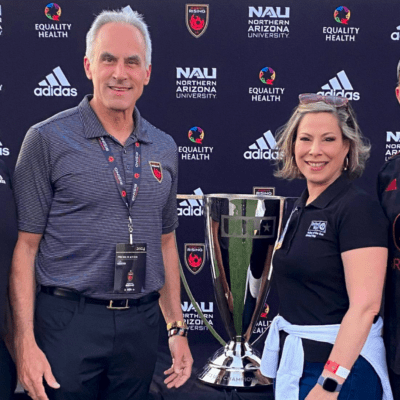Cover Story: Pilots and Platelets
 How Volunteers Fly to Keep Blood Flowing
How Volunteers Fly to Keep Blood Flowing
By Mike Saucier
It’s six in the morning on a recent Monday and Scott Smith is carrying a box of blood platelets to his plane outside his hangar at Falcon Field in northeast Mesa.
Smith, the former Mesa mayor and gubernatorial candidate, slides the hangar’s giant door open, revealing a four-seat Cirrus SR22, a 26-foot airplane he flies for leisure and also in his role as a volunteer pilot for Flights for Life.
He pulls the plane out of the hangar and prepares for a 37-minute flight to Flagstaff, where the platelets box will be picked up by a United Blood Services driver and transported to Flagstaff Medical Center, the only trauma center north of the Valley. The blood it receives from Flights for Life saves lives.
It was a United Blood Services driver, Veronica Wallace, who had dropped off the box that Smith would take to Flagstaff. She would do the same for another pilot that morning, this one bound for Show Low.
Smith and 95 or so volunteer pilots who rent or own aircraft make similar trips every weekday. Many are retired Air Force and commercial airline pilots who just love to fly. They are all committed to the cause – ferrying blood by air with unmatched views of desert expanse all around them. Through Flights for Life, they help the critical blood flow continue in Arizona.
Pilots in the Phoenix area formed the group in 1984 to help United Blood Services, the state’s top blood supplier, in addressing health care problems plaguing the Southwest for years: getting blood to small or remote medical facilities and helping avoid blood shortages. In 2016 alone, they flew 1,019 missions that carried 2,103 boxes of blood.
Smith, the CEO of Valley Metro, found out about Flights for Life by chance six years ago at Falcon Field. He was looking for a way to keep flying and was sitting outside of his hangar one day and noticed the hat of the guy renting the hangar next to him. It was a Flights for Life hat.
“I had been talking about how I was frustrated that I was so busy I wasn’t able to fly as much and he said Flights for Life will give you a reason to fly,” Smith said. “And boy he was right. I never stopped.”
Smith now flies two or three times missions a month to deliver boxes of blood platelets, usually to Flagstaff or Show Low. He estimates he’s done 130 mission flights, all of them out of Falcon Field, an airport established during World War II to train British Royal Air Force and American pilots.
Smith, who wanted to go into the Air Force when he was younger, said he’s always wanted to fly. His wife gave him flight lessons for Christmas one year after he spent a good chunk of a night out with friends talking about his love for flying.
“I didn’t really want to go,” Smith said. “I was busy and everything – and this friend was just persistent and said, ‘I’ll meet you out there at six I the morning, you have no excuse.’ And once I got in the air and actually started flying I just got the bug, I loved it.”
Smith typically makes his blood flights early in the morning because it fits into his work schedule better.
“Everyone in Flights for Life donates their plane, their time and their fuel – it’s just a great way to get out and know you’re doing good,” he said. “It’s almost like you shouldn’t get credit for doing it because I love flying, especially in Arizona. And if you’re delivering blood it just makes it special.”
The missions by Flights for Life pilots serve the need for a safe and ample blood supply in Arizona. There are many parts to the broad system of blood centers, hospitals and health care. But the key player linking it all together is United Blood Services, Arizona’s largest non-profit community blood supplier for more than 60 Arizona hospitals.
United Blood Services supplies 90 percent of the hospitals in the state – and the need is always there. Nearly 500 blood donors are needed every day across Arizona and about one out of every five hospital patients need blood.
Volunteer donors supply almost all blood and its components, which are tested, processed, stocked, and distributed by United Blood Services at its main facility in Scottsdale. That’s where the platelets that Smith brought to Flagstaff were separated from the whole blood, allowing several patients to benefit from a single blood donation. Platelets are often needed by patients with leukemia and cancer.
The blood is often driven from Scottsdale to hospitals all across the state. Flights for Life pilots cut the travel time for the blood, and also help save United Blood Services save money on drivers, gas and vehicle maintenance. Flights for Life missions carry no cost to the nonprofit.
“Without them we would have to find another way to get platelets up to Flagstaff,” said Brian Beach, hospital services manager at United Blood Services who works with Flights for Life to coordinate all the deliveries. “They’re not only for scheduled missions. If we get a stat right now to Show Low, we’ll put out a page to all of the pilots and someone will respond, weather permitting. Obviously it’s a lot quicker for us to fly up there than it is to drive.”
Beach said Flights for Life saves United Blood Services about $1 million every three years.
The platelets flight, such as the one Smith made to Flagstaff, happens every day, Beach said.
“What he has in that box can pretty much handle everything in the region,” he said. “The platelets stay at the Flagstaff Medical Center but if the other hospitals need them we have a carrier service.”
Getting the blood where it needs to be, as soon as possible, is a constant logistical dance for United Blood Services.
“In the outlying areas we’re putting product on their shelf and we do it strategically,” Beach said. Smaller hospitals in Yuma, Page, Show Low and Winslow need platelets and rely on United Blood Services to make sure they have them.
Beach coordinates the flight missions to Flagstaff, Yuma and other outlying areas. Every month, the volunteer pilots sign up for their missions and Beach schedules them quickly and according to need.
“When we have a stat, to us that’s when they really shine,” he said of the Flights for Life volunteer pilots. “Obviously, it’d take us four hours to get to Show Low. They can fly over the mountains in a half hour. So it’s incredible to have them.”
The pilots “love to fly and they like to do something that’s good for the community,” he said.
That’s a sentiment contained in the words of Flights for Life’s founding president, Ed Gentry, who said the group was formed was because pilots “wanted to do something more important with their planes than poke holes in the sky.”
Beach said that before Flights for Life, pilots used to say that they flew their planes for “a $100 hamburger,” meaning that they would spend $100 in fuel just to go somewhere – Flagstaff, or maybe Yuma – to grab a hamburger for lunch. Now, they may still get a hamburger, but because they’re also carrying blood, their flights have acquired a whole new meaning.
“They’re doing something important,” Beach said.
And it’s getting noticed. Flights for Life units are being established in New Mexico and Texas. There are requests for Flights for Life in California and Nevada. They have also received calls from pilots from Alaska and Tennessee saying they too want to help out.
Sue Thew, a spokeswoman for United Blood Services who has been with the nonprofit for 30 years, said the role the Flights for Life pilots play is crucial because blood picked up from blood drives in outlying locations needs to be processed within eight hours after donation in order to get plasma.
The clock begins ticking as soon as the blood leaves the donor. It may have to travel by car to an airport and, from there, by plane to the Valley, where it is driven to Scottsdale to be tested and processed at the United Blood Services lab. It is only then that it can be distributed to the hospitals that have requested it.
“You only have so many hours to get it into the freezer,” Thew said.
United Blood Services, founded in 1943, is a 24/7 operation. It is the largest nonprofit healthcare organization in the state, and it does whatever it takes to get blood where it needs to go – “whether it be through a Flights for Life pilot who donates all their time, their fuel, their plane to get blood wherever it’s needed, or drivers in the Valley,” who cover shorter distances, Thew said.
The Scottsdale lab is the heartbeat of all this activity, the central distribution facility for all the blood that goes to any hospital in Arizona (with the exception of Bullhead City, which is serviced by the Las Vegas facility because it’s closer).
“A lot of people don’t realize that you can’t wait until an emergency to donate blood,” Thew said. “Since it takes 24 to 36 hours to test and process blood you have to make sure it’s on the shelves when you need it. So United Blood Services has already recruited the donor, processed and tested the blood and perhaps even given it to a Flights for Life pilot for delivery to a hospital before a patient even has a chance to receive it.
Stories abound about people whose lives have been saved from blood transfusions. One of these is the story of Tempe Police Officer Scott Tipton – who, responding to a call in 2000, was shot seven times and, as a result, required 27 blood transfusions, which had to be flown in. For Thew, that is what helps drive home the point that she is part of a system that can be the difference between life and death.
Tipton credits blood donors for saving his life and, 15 years later, speaks at Flights for Life events.
Flights for Life has also delivered blood for United Blood Services during other emergencies, such as the deadly shooting at Northern Arizona University in 2015 and countless accidents that don’t often make headlines.
Thew understands first hand the importance of a robust blood supply and well-run blood system. In October her brother had a hemorrhage and was rushed to the hospital. “Over the next 36 hours, he received more than two dozen transfusions. While the blood wasn’t enough to save his life,” she said, “it gave him his only chance of survival and for that I’m truly grateful.”
Back near Falcon Field, Smith is checking the gadgets on the dashboard as he’s about to land his Cirrus. He has dropped off the box of blood platelets at Flagstaff Pulliam Airport; the platelets are bound for patients at Flagstaff Medical Center and beyond. Flying around Arizona for Flights for Life has enabled him to see the state in ways not many people get to see it – from above, in all its splendor – while also playing a part in saving lives.
“Once I started getting to know United Blood Services and hearing the stories about the people who had their lives saved, people who had been in horrible accidents, and how United Blood Services and Flights for Life respond in an emergency and fly liters of blood up to a remote hospital and basically save a person’s life … you hear stories like that and then you feel you do have a personal connection, even though you don’t know the person,” Smith said.
Plus, there’s the added bonus of meeting like-minded people.
“I’ve developed a whole new group of friends,” Smith said. “That’s what’s been fun.”
It’s not yet 10 in the morning and Smith has flown to Flagstaff and back. As an executive of an agency that specializes in moving people safely from point A to point B, it’s fitting that he has many more miles under his belt before noon than most people will have the entire day.





